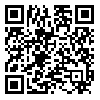Volume 6, Issue 2 (December 2020)
Elderly Health Journal 2020, 6(2): 122-130 |
Back to browse issues page
Download citation:
BibTeX | RIS | EndNote | Medlars | ProCite | Reference Manager | RefWorks
Send citation to:



BibTeX | RIS | EndNote | Medlars | ProCite | Reference Manager | RefWorks
Send citation to:
Rebecca D, Eicher C, Ferizaj D. Evaluation of a Music Intervention on Well-being and Behavior of People with Dementia Using Dementia Care Mapping. Elderly Health Journal 2020; 6 (2) :122-130
URL: http://ehj.ssu.ac.ir/article-1-196-en.html
URL: http://ehj.ssu.ac.ir/article-1-196-en.html
Geriatrics Research Group, Charité – Universitätsmedizin Berlin, Berlin, Germany , rebecca.dahms@charite.de
Abstract: (2839 Views)
Introduction: Dementia Care Mapping (DCM) was originally developed as an observation tool to examine person-centered care in long-term care facilities and to evaluate the quality of life and well-being of people with dementia (PwD). However, the effects of a music intervention using this tool have not been investigated so far. This leads to the following research question: How does a music intervention which involves music therapy and other music-based interventions affect the observed well-being and behavior of PwD living in nursing homes?
Methods: In this 14-week, non-controlled music intervention study, data from 30 PwD aged between 52 and 97 (M = 81.4 years) were analyzed. DCM coding involves continuous observation for five hours on four days in the baseline and intervention phase. In the follow-up phase PwD were mapped on two days for five hours. The DCM method were used to measure well-being and certain behaviors of PwD.
Results: The well-being during the observation remained almost constant and corresponds to a neutral state of affect and focused contact, with no indication of positive or negative sensations. Significant improvements in certain behaviors were observed in the course from baseline to intervention phase. For example, it was shown that physical activities of the participants, such as (instructed) sports exercises, strengthening or physically challenging exercises in the intervention phase were significantly higher (M = 0.99, SD = 1.82) than at baseline phase (M = 0.00, SD = 0.00) (z = -2.37, p = .02, n = 26). Similar results were shown for expressive/creative activities or work-related activities (e.g. washing dishes).
Conclusion: In summary, it can be stated that music interventions can promote communication and movement. However, musical stimulation is not one of the essential components of improving behavioral and psychological symptoms or well-being for PwD in nursing homes.
Methods: In this 14-week, non-controlled music intervention study, data from 30 PwD aged between 52 and 97 (M = 81.4 years) were analyzed. DCM coding involves continuous observation for five hours on four days in the baseline and intervention phase. In the follow-up phase PwD were mapped on two days for five hours. The DCM method were used to measure well-being and certain behaviors of PwD.
Results: The well-being during the observation remained almost constant and corresponds to a neutral state of affect and focused contact, with no indication of positive or negative sensations. Significant improvements in certain behaviors were observed in the course from baseline to intervention phase. For example, it was shown that physical activities of the participants, such as (instructed) sports exercises, strengthening or physically challenging exercises in the intervention phase were significantly higher (M = 0.99, SD = 1.82) than at baseline phase (M = 0.00, SD = 0.00) (z = -2.37, p = .02, n = 26). Similar results were shown for expressive/creative activities or work-related activities (e.g. washing dishes).
Conclusion: In summary, it can be stated that music interventions can promote communication and movement. However, musical stimulation is not one of the essential components of improving behavioral and psychological symptoms or well-being for PwD in nursing homes.
Type of Study: Research |
Subject:
General
Received: 2020/07/16 | Accepted: 2020/10/5 | Published: 2020/12/28
Received: 2020/07/16 | Accepted: 2020/10/5 | Published: 2020/12/28
Send email to the article author
| Rights and permissions | |
 |
This work is licensed under a Creative Commons Attribution-NonCommercial 4.0 International License. |








